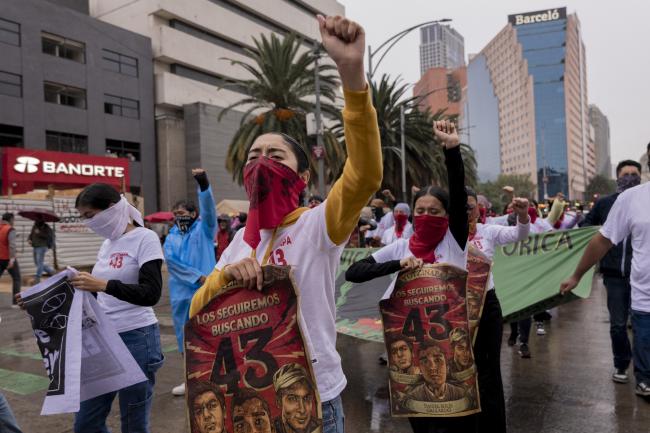
Hundreds of teachers’ college students make their way through the streets of Mexico City, chanting and marching in unison. Half-covered by bandanas, their faces reveal piercing eyes, defiant as they walk along Reforma Avenue heading towards the Zócalo, the city’s central square.
They howl together, a guttural, deafening chorus that drowns out the noise of Mexico City: “Alive they took them, alive we want them.”
It is September 26, 2024, on the fourth consecutive day of mobilizations in the capital, just hours before the 10-year anniversary since 43 normalistas from the Ayotzinapa Rural Teachers’ College were forcibly disappeared. A decade after the case sent shockwaves across Mexico and beyond, the fate of the students remains shrouded in silence. The disappeared were young men just like the demonstrators that fill the city streets, their lives violently suspended in time and place.
A few days later, on October 1, Claudia Sheinbaum will be sworn in as Mexico’s first woman president. A protege of outgoing President Andrés Manuel López Obrador, she was elected in June with nearly 60 percent of the vote. On the Ayotzinapa anniversary, Sheinbaum promised to work with the families of the victims to uncover the truth. Yet, her commitments echo the unfulfilled promises of her predecessor, and it remains to be seen how she will address Mexico’s crisis of disappearance.
The “Historical Truth”
Ayotzinapa remains an inconvenient truth, an open wound in the Mexican psyche. On that fateful night in 2014, five buses carrying students were attacked by municipal and federal police, the army, and organized crime groups in Iguala, in the state of Guerreo. The assault left six dead and 43 missing, igniting national and international outrage in a nation where mass graves have become all too common. An estimated 100,000 people are missing across Mexico, a grim statistic that reflects a deepening forensic crisis.
The investigation has faced a decade of obstruction and deceit, with officials manipulating narratives to shield those responsible. In 2015, the Attorney General’s Office attempted to close the case by installing a “historical truth,” asserting that the students were intercepted by members of the cartel Guerreros Unidos, killed, and incinerated in a garbage dump 15 miles away. Established through state torture and the fabrication of evidence, this narrative systemically erased the role of the Mexican military and police in perpetrating the crime.
However, family members of the disappeared, experts like the Argentine Forensic Anthropology Team, and investigative journalists—including Marcela Turati, Pepe Jimenez, and John Gibler—refused to accept this false narrative. They tirelessly retraced the events and pressured authorities to reopen investigations that linked the case directly to higher authorities, including top military officials.
AMLO’s Unfulfilled Promises
When Andrés Manuel López Obrador (AMLO) took office in 2018, he promised to prioritize uncovering the truth behind Ayotzinapa. Two days after his inauguration, he signed an executive order creating a new commission to investigate the case and invited back the Interdisciplinary Group of Independent Experts (GIEI), a committee of international specialists formed by the Inter-American Commission on Human Rights, which had been expelled by the administration of Enrique Peña Nieto in 2016.
“He told us we were going to know the truth about what happened to our kids,” says Francisco Lauro Villegas, the father of one of the missing students, at the anniversary protest in Mexico City. Yet six years later, that promise remains unfulfilled. The investigation stalled when it revealed evidence of top military involvement, a line that many observers believe AMLO could not—or would not—cross.
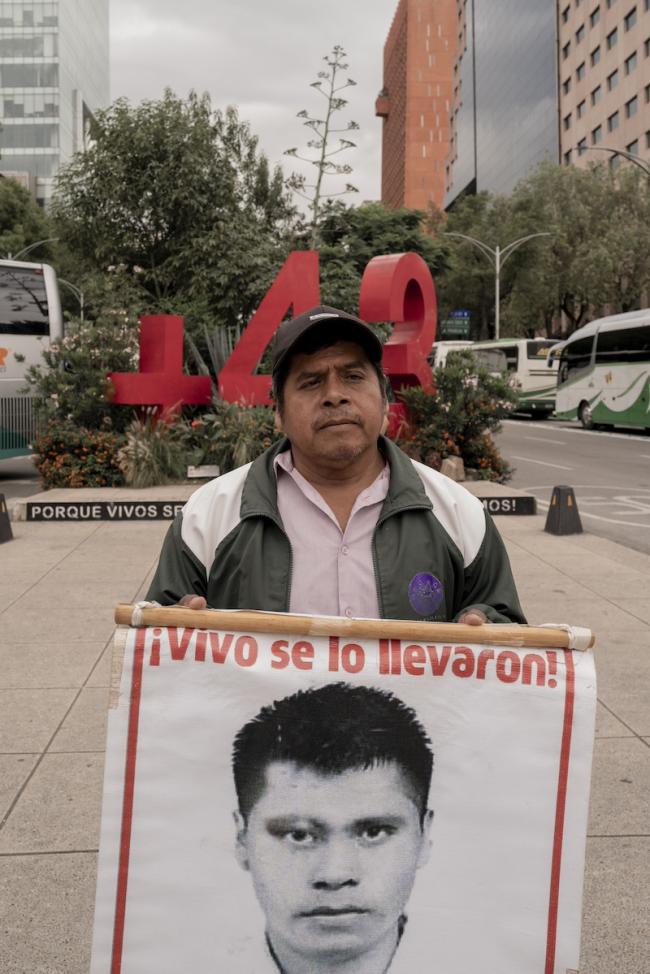
In recent years, three different investigative teams made notable progress on some aspects of the case. The AMLO administration officially recognized that it had been a state crime and partial remains of two of the missing students were identified, serving to further unravel the “historical truth.” More than a hundred people have been arrested, including some military officials who were released on bail, but no high-level official has been convicted for the crime. No one involved—from the Army and Navy, to local and federal police, to the Guerreros Unidos cartel—has revealed what was done to the students or why.
Omar Manuel Vázquez Arellano is a survivor of the attack who now serves as a federal deputy for AMLO’s Morena party. “To carry out his national development plan, he had to rely on the Armed Forces,” says Vásquez Arellano of AMLO. “That was a strategic mistake,” he adds, echoing widespread concern about the enhanced role of the military in everyday life in Mexico.
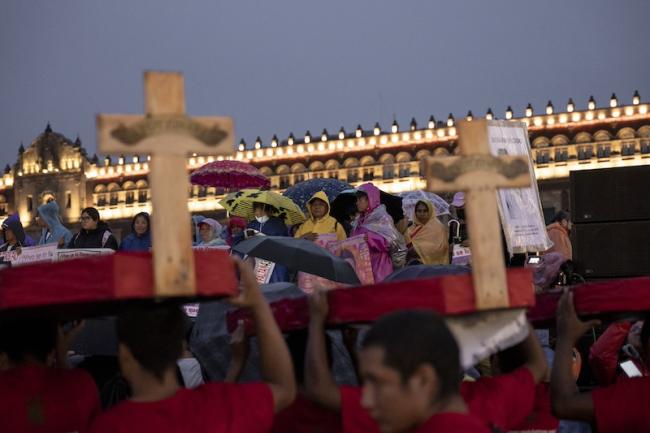
Despite promises to demilitarize the country, AMLO has granted the Armed Forces unprecedented authority over areas previously under civilian control, a development that has disappointed those who have long critiqued the militarization of public security. “We were too permissive during this six-year term,” Vázquez Arellano noted, referring to major collaborations between the government and military, including granting the Armed Forces authority over the construction and management of the controversial Tren Maya project.
Omar Gómez Trejo, the special prosecutor assigned by AMLO to lead the GIEI, uncovered strong evidence of military surveillance over and involvement in the attack, including direct coordination with the cartel Guerreros Unidos. This evidence became a barrier to the investigation moving forward, and AMLO intervened to stop it in its tracks.
As the 10th anniversary comes and goes, families cling to hope that has become increasingly fragile.
The Collective Struggle for Memory Continues
Zoe Juárez García, 15, stands on a shared bicycle with her father, Miguel Ángel, making their way to the Angel of Independence monument in downtown Mexico City for the anniversary march. Her face is covered with a handkerchief that reads, “43 are missing, pinche Estado [damn government], count them well.”
Juárez García first learned about Ayotzinapa when she was 10. Though she can’t yet vote, she hopes for a different future for Mexico. “What we want is for them not to tell us more historical lies, to show those who did wrong,” she says of the government.
Watching her warmly, her father feels the weight of this uncertain future. “Knowing that my daughter can go to a demonstration and not return is very difficult,” he confesses. He had voted for AMLO, but feels disappointed by his unfulfilled promises.
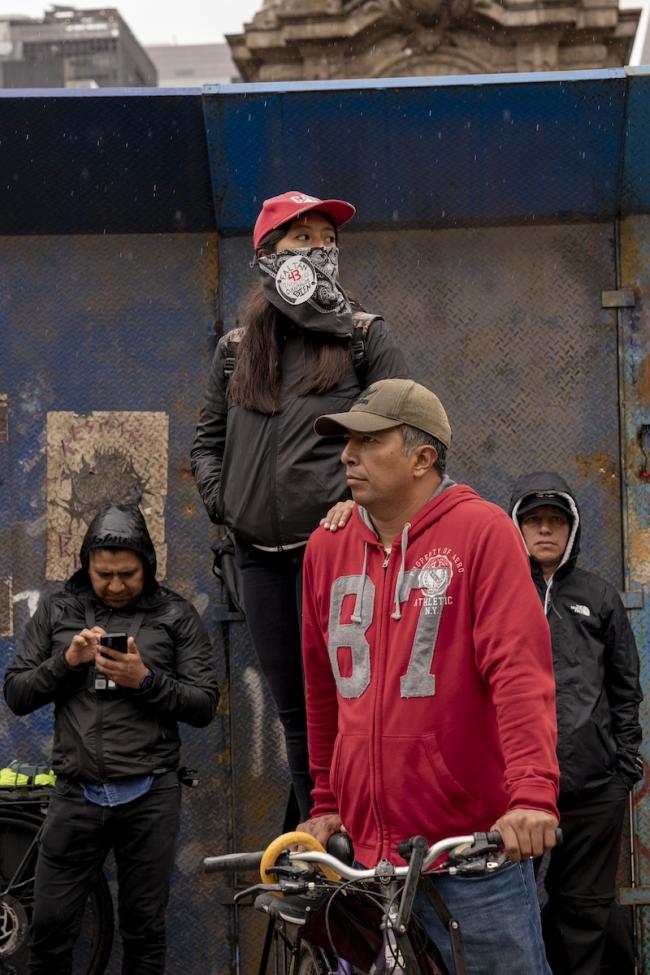
Around them march university students, teachers, and representatives of human rights organizations. Ayotzinapa resonates on multiple levels: it embodies an enduring history of state violence, collusion with organized crime, and the painful search for truth amid a crisis of disappearance that continues to devastate families.
For many young people, Ayotzinapa represents a political awakening similar to what the 1968 Tlatelolco massacre represented for their parents. On October 2, 1968, more than 300 people were killed by the Mexican military while repressing a series of university student protests. The Ayotzinapa students were headed to an event commemorating Tlatelolo on the night they were intercepted and disappeared.
Eva, a sociologist who was 25 when the events unfolded, stands next to her friend Monserrat. They both requested to be identified by first name only. “We were filled with rage and sadness,” she recalls of the mass disappearance, her eyes brimming with tears. “To return to the streets after 10 years is incredibly upsetting.” While Eva believes AMLO had some political will to resolve the case, she agrees that more could have been done—a sentiment echoed by countless government supporters.
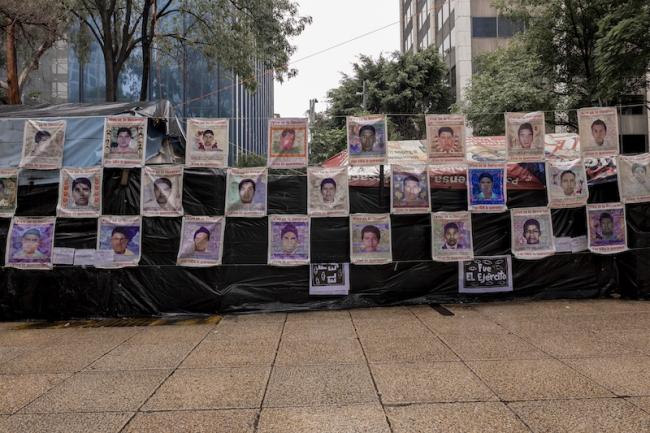
Families view incoming resident Sheinbaum's choices skeptically, including appointing Omar García Harfuch as her secretary of security. García Harfuch was a state coordinator of the federal police in Guerrero when the Ayotzinapa crimes occurred, and some have alleged his involvement in previous cover-ups.
“It’s a bad sign for us,” says Mario César González Contreras, father to one of the missing students. “All we have left is to hope for some sensitivity, because she’s a mother and we hope she will be empathetic to the searching mothers.”
María Luisa Aguilar Rodríguez of the Prodh Center, a human rights organization, voiced concern that decisions like naming García Harfuch as a trusted advisor signal a reluctance to pursue the investigation, and are part of a wider pattern of the state ignoring and suppressing Mexico's forensic crisis. “It sends a message that [state] institutions remain unchanged,” she said, highlighting the need for political will over political timing.
Across Mexico and beyond, Ayotzinapa has become a symbol of forced disappearance, part of a wider transnational struggle. Paula Mónaco, an Argentine journalist living in Mexico, stood alongside the march with her 13-year-old son, Camilo, who was just a toddler when Ayotzinapa happened. Despite the rain, he proudly supports his mother, whose own parents were disappeared by the Argentine dictatorship in 1977.
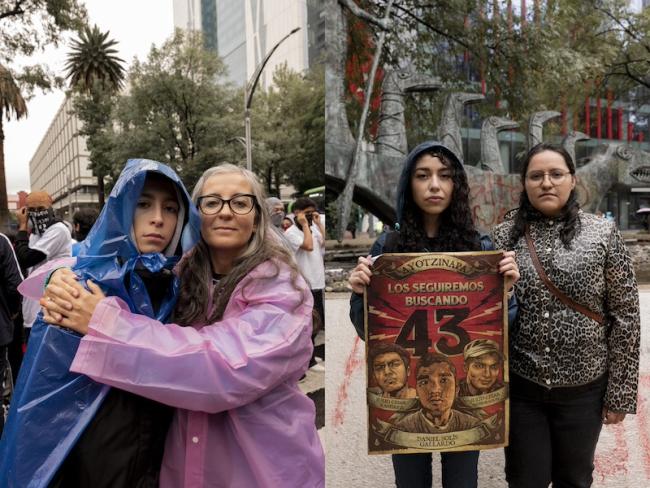
“My mom has familiares desaparecidos,” disappeared family members, Camilo says, echoing a transnational legacy of searching and loss. “I’m here to support her and the relatives of other missing people. It’s tough to think it’s been 10 years,” he admits. “But from my family’s experience, hope is never lost.”
“I was born with an absence,” Mónaco says, wrapping an arm around her son. “By accompanying the families of Ayotzinapa, I’ve seen how such absences destroy lives.”
Ayotzinapa transcends individual cases, representing a collective struggle for memory and justice. Mónaco hopes the drive for truth will endure. “I hope we can build more memory,” she says, standing firmly in the rain. “Not just for the families of the 43, but for the sake of us all.”
Lucía Cholakian Herrera is a freelance reporter from Buenos Aires covering politics and human rights in Latin America.
Anita Pouchard Serra is a French-Argentinian photojournalist and visual storyteller working around migrations, identities, territories, and memories. She is based in Buenos Aires and works between Latin America and France. This reporting has been done with the support of Leica Camera Mexico

